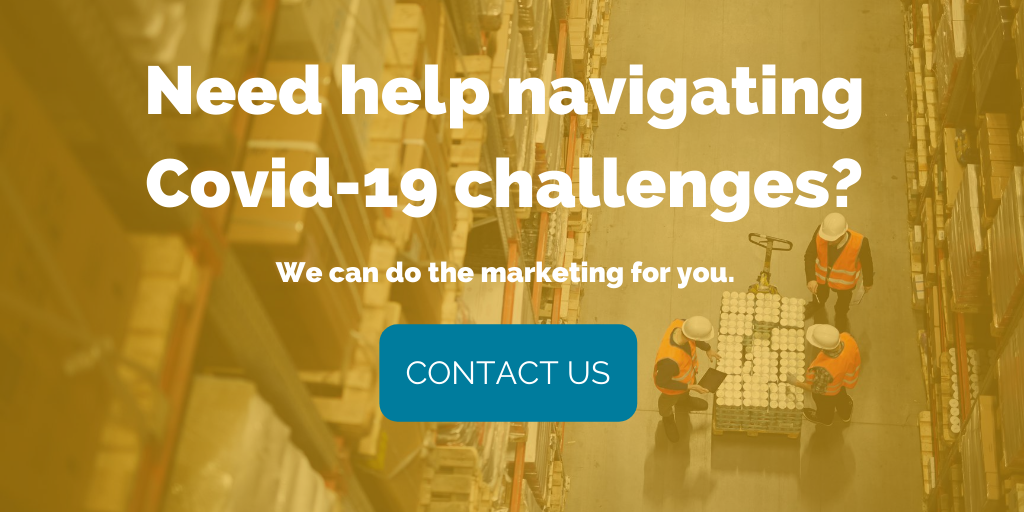
by Fronetics | May 19, 2020 | Blog, Covid-19, Current Events, Marketing, Strategy, Supply Chain
From answering the most important question to humanizing your company, make it part of your Covid-19 messaging strategy.
If your organization put marketing on pause to deal with the impact of Covid-19, it is time to recharge — thoughtfully. But what should your Covid-19 messaging strategy look like? What should you say and where should you say it?
More than any other industry, Covid-19 thrust the supply chain into the eye of the storm. Now, after a few months of intense disruption, a new normal has set in, giving companies in every supply chain vertical a chance to evaluate how to best position their business at a time of great uncertainty.
Since supply chain partnerships are rarely forged overnight, consider the benefits of not only looking after current clients and stakeholders but also extending a hand to new leads. Faced with unprecedented challenges themselves, these potential prospects may be searching for solutions just like yours.
Question is: What will they find when they come across your website and social channels?
Let’s take a closer look at the key components of a Covid-19 messaging strategy for supply chain companies.
Answer the No. 1 question
Yes, you are open for business. Make it clear on the homepage and update your social media profile with the latest facts. Do not let visitors go searching for that one piece of vital information. Although the immediate urgency and upheaval of the first few weeks of the pandemic is waning, the economic repercussions are just starting to be felt, and the question of whether your organization is still in business needs a quick answer. A pop-up message or banner will get the job done. Include a CTA that leads to a landing page on your organization’s Covid-19 response.
Create a dedicated landing page
What is your organization doing to protect employees and clients? Are you experiencing any service interruptions? Do you serve shelter-in-place areas? The landing page can answer all of those questions. Consider the landing page a resource for your clients and prospects. It may include the company crisis communications plan, a direct message from a company executive, links to helpful resources, and more.
Pick the right topics
Like many others, you may have published an initial statement on the crisis and your dedication to helping clients navigate through it. Where do you go from here? Sounding salesy or overly eager to promote your own supply chain solutions can come across as desperate. And moving on like nothing has happened will likely strike visitors as detached.
Take the perspective of your current clients and prospects — what do they want to know about your services at this time? Their priorities have undoubtedly changed since last year.
Many supply chain companies are uniquely positioned to talk about themselves since they truly are part of the solution to the disruption of goods and services. A provider of flexible warehouse space can publish a post on the importance of building a resilient supply chain that can sustain the impact of unexpected events. And an IoT leader may discuss how its fleet app can keep overworked drivers safe.
The voice of the company should echo throughout your site. Update wording that may seem inappropriate or out of place now. Speak with clarity and authority. Give prospects a sense that you really understand what they are going through (because you do). And, most of all, keep publishing relevant content. A dormant blog or resource page sends the wrong message.
Humanize the company
Being able to connect on a personal level with businesses is gaining in significance. Even in the B2B space, it is a strategy that has worked well for many of our clients. This is even more true during a crisis with such a devastating toll on public health as Covid-19.
We have seen CEOs step up to speak directly on camera to clients or let themselves be interviewed about the company’s crisis response. Team members can be featured, too, in video snippets, showcasing any PPE donations or in-the-field work. Videos and personal stories also tend to foster engagement on social media. Again, keep the tone and content aligned with your target audience.
Final word
Your Covid-19 messaging strategy can have a big impact. Think tactful and empathetic. Stay active and engaged. We know this is a challenging time for so many. Getting your messaging right is a good place to start.


by Fronetics | May 13, 2020 | Blog, Covid-19, Current Events, Marketing, Strategy, Supply Chain
With a main lead-generating source canceled or postponed, trade show contingency plans take on increased importance.
The Supply Chain USA 2020 summit in Chicago is a flagship event. Considered a must-attend gathering for strategic decision-making, it draws 1,000 supply chain and logistics leaders for three “unmissable days.”
For executives like Tom Schmitt, chairman and CEO of Forward Air Corp., it is the type of event that generates so many “relevant conversations” that he says it is like getting the value of nine business trips for the price of one.
This year, though, those who planned to head to Supply Chain USA, June 16-18, will need to start working on their trade show contingency plans. The fallout of the coronavirus pandemic has forced EFT, the organizer, to postpone and a new date has yet to be determined.
And — as you have likely experienced yourself — the summit attendees are hardly alone. Within weeks of the Covid-19 outbreak, 1 million people saw their corporate event plans scuttled. MODEX in Atlanta, Ga., in early March, turned out to be one of the last hurrahs for supply chain professionals — half of the pre-registered attendants were no-shows — before cancellations and postponements turned the supply chain conference circuit on its head.
Now, supply chain pros wonder, “What’s next?”
Covid-19 forces domino of cancellations, postponements
A look at this list gives you an idea of the impact: (Check event websites for the latest info)
Trade show contingency plans need to fill big lead generation gap
For supply chain and logistics companies, the cancellations and uncertainty surrounding the postponed shows are no small matters. Trade shows are one of the largest lead generators for B2B demand generation.
Technology and service providers spend an average of 11% of the marketing programs budget on third-party tradeshows, according to the Gartner 2019 Tech Marketing Benchmarks Survey. And the investment seems to be paying off, as 18% of the same companies rank events as the best-performing calls-to-action of marketing-qualified leads, second only to content assets.
Another survey, by MarketingCharts, found software and technology companies cite events as the most effective demand-generation tactic for attracting top-of-the-funnel qualified leads.
In other words, the need to develop trade show contingency plans is quite urgent.
Trend watch: What some companies are doing
So, what actions have some of your peers taken to date to make up for the loss of face-to-face networking?
Some trends are emerging, including:
E-learning: To ensure business continuity while adhering to stay-at-home policies, DC Velocity notes e-learning has taken on increased significance. The establishment of interactive online courses allows companies to conduct specialist training sessions on complex topics that attendees can complete at their own pace. (E-learning is usually a time-consuming and fairly costly endeavor but can serve its purpose when the audience already has an invested interest in the company. For quick engagement, we recommend webinars.)
Dropped subscription fees: On-premise platforms that run on business servers are not conducive to remote work — and vendors of cloud-based supply chain software have seized the market opening. For the sake of lead generation, a range of companies have dropped subscription fees, offering free access to products like transportation management, route optimization, last-mile visibility, and remote robotic operations. One example: InMotion Global, Inc., has made its cloud-based platform, AscendTMS, available at no cost to any company needing help for 30 days.
Quick actions matter
The fact more people are spending more time than usual on their computers provide an opening for companies that can leverage trade show contingency plans. Gartner, for one, advises teams must be prepared to quickly pivot marketing strategy and build campaigns to address this shift.
Immediately after a cancellation or postponement, actions may include:
- Replace all scheduled event meetings with online meetings within 24 hours.
- Create a webinar series that homes in on the key messages you had planned to convey.
- Develop a series of video posts for the company blog that leverage the materials you prepared for speaking sessions and in-booth presentations.
- Promote all content on social media (Video content generates better engagement).
- Combine paid advertising and account-based marketing to target potential buyers.
- Inquire whether there are any opportunities to use the digital channels of the show host for promotions.
Stay relevant — at a distance
Although it may feel like unchartered territory, you really can have relevant conversations online. Base your opening statement on a trade show contingency plan.


by Fronetics | May 6, 2020 | Blog, Content Marketing, Covid-19, Current Events, Marketing, SEO, Strategy, Supply Chain
So much to say, so little time. Supply chain marketing during Covid-19 — leaning in is better than backing out.
Turmoil does not quite begin to describe the situation that supply chain companies have experienced lately. The Covid-19 pandemic threw in just a few weeks the finely calibrated, just-in-time supply chains into a state of disarray. In the midst of the struggle to get product from Point A to Point B — while also ensuring the health and safety of employees — many companies had little choice but to adopt an all-hands-on-deck approach.
We saw it ourselves as our clients were suddenly buried in challenges that only weeks earlier had posed no issues at all — securing electronic parts overseas, locating warehouse space, finding freight forwarders, moving product out of port, and more.
If supply chain marketing during Covid-19 had to take a backseat during the initial phase of the crisis, beware of staying quiet for too long. Letting your marketing channels sit idle for an extended period, or drastically scaling back at a time when communication matters more than ever, is not a risk-free strategy.
Let us explain why:
Covid-19 supply chain marketing: Lean in or risk losing ground
Go silent — or stay strong
In the wake of the first shockwaves of the Covid-19 pandemic, supply chain companies understandably had to devote extensive resources to regain their footing. Few industries felt the impact as deeply as the supply chain. For some, the disruption opened up a flood of new business, sending the entire organization scrambling to keep up. For others, it meant every budget line item had to be scrutinized.
At the same time, we noted another challenge brewing for busy organizations: Maintaining a strong online presence during a tumultuous time. How do instill confidence in current customers and gain new leads if you say little or nothing at all?
After the first flurry of crisis-related marketing emails that many of us received (“We are here to help”), some companies — overwhelmed by the scope of work — let their social media accounts go silent and blog pages seized being updated.
The risk? Taking a break or withdrawing altogether could put your organization in a worse position later.
A McKinsey study underscores this point — conventional downturn strategies can actually hamper recovery. The performance analysis of 700 high–tech companies during two decades of market contractions showed “making obvious moves (for instance, cutting costs) as well as counterintuitive ones (such as increasing sales and marketing expenditures) quickly can improve a company’s position when the recovery begins.”
Interestingly, the best-performing companies increased their marketing and advertising spend relative to their competitors, but also compared to their own spending when times were better. However, from our perspective, the issue is far from just spend but identifying the most effective marketing channels and tactics at a time when resources may be scarce.
Weaken SEO — or make it soar
The risk of cutting back on supply chain marketing during Covid-19 also extends to search engine optimization (SEO). Rather than a one-time project, SEO needs constant attention to hum. It is the foundation of your effort to improve the quality and quantity of unpaid website traffic by increasing the visibility of your site or page to search engine users.
SEO and content go together
The completion of a well-designed website is only the beginning. If there is anything SEO demands more than anything else, it is content. You simply cannot ace one without the other. New, key-word optimized content is what makes SEO tick. Google Search has for years used a freshness algorithm to index pages. This means fresh content gets rapidly indexed and lands higher in search rankings than older content.
Backlinks — other reputable sites linking to your content — are also crucial to building SEO. When you provide up-to-date, insightful content, chances increase others will notice and link back to your site, especially during a time when so many are online searching for information. The same goes for backlinks and traffic to your site generated by social media.
So, what is the risk of going quiet?
The short of it: SEO can suffer. If content was the backbone of your marketing strategy before the pandemic hit, your organization has likely established a history of domain authority and is, as a result, in a better position to weather the storm. But not even the best of sites can escape the reality of what matters to search engines. Although you can still squeeze juice out of old keywords, lack of new content puts your organization at a disadvantage when search engines evaluate your pages in competition with countless others.
So much to say — can you find the time?
In many respects, supply chain marketing during Covid-19 comes down to this: Who would you want to do business with during a time of great uncertainty? What signals do you want to send to your audience? What do you want to tell them? As challenging as it may be, leaning in is better than backing out.


by Fronetics | Jan 28, 2020 | Blog, Logistics, Marketing, Social Media, Supply Chain
Digital marketing over social media is a trend that continues to grow, but it’s only effective if you’re doing it right. Here are social media mistakes supply chain brands are still making.
Highlights:
- When it’s done right, there’s no greater tool for your company to increase brand awareness and generate leads than an engaged presence on social media platforms.
- Knowing what content hits home with your followers and potential followers is crucial.
- The most successful companies on social media are the ones that find innovative and creative ways to engage with users.
It’s no mystery why approximately 81 percent of small and medium businesses maintain a social media presence. With 3.5 billion users worldwide, social media is a dream come true for businesses looking to reach a ton of potential customers.
Digital marketing over social media is a trend that continues to grow, as more businesses jump on the social media bandwagon. When it’s done right, there’s no greater tool for your company to increase brand awareness and generate leads than an engaged presence on social media platforms. But it can be virtually useless if your company isn’t doing it right.
Traditional marketing strategies may be misleading for companies hoping to connect with customers over social media. And familiar ways of using social media for personal use can also lead marketers astray. The most effective use of social media for your business centers on knowing your audience and positioning your brand within the right conversations, rather than promoting your product or service.
Are you making social media mistakes? Check out our list of the most common blunders we see companies making to find out.
Mistake #1: Not knowing the audience
Everyone understands how a billboard works. It advertises something for sale where it can be seen by as many people as possible. But for companies looking to increase their effectiveness, that’s a big social media mistake. The most important thing a brand can do on social media is to engage dynamically with other users. And to do that, companies first have to figure out who their audience really is.
It’s surprising how often brands don’t have a clear idea of who they’re trying to connect with on social media. Knowing what content hits home with your followers and potential followers is crucial. And collecting followers and promoting your brand visibility with the right audience means figuring out what other interests your target demographics might have.
So, how do you develop a profile of who your audience is? The first step is to put together a detailed description of your target buyer persona. It’s important to consider details such as the location, education level, and role in the industry of the buyers you’re hoping to reach. Based on this profile, marketers can more precisely pinpoint the needs and concerns of their target audience. This is vital for being able to anticipate the groups to join where potential buyers are most likely to be found.
Bottom line: engage with your audience! Once you have figured out who that audience is, join groups, encourage and leave comments, and pay attention to what your followers care about.
Mistake #2: Using objectives instead of strategy
The best way to use social media for digital marketing involves developing a clear strategy for attracting followers, delivering content, and achieving an ROI. Unlike personal use of social media, effective digital marketing depends on maintaining a regular schedule of generating content. Knowing how often to post content or update profiles can make a huge difference for staying on the top of newsfeeds at key times of day.
Generating new content is crucial for keeping followers engaged and attracting the attention of potential new followers. A variety of different kinds of content prevents followers from tuning out or skimming past your company’s posts. Partnering with brand ambassadors and market influencers boosts the organic visibility of your brand: by working with prominent social media users, your company can benefit from dynamic interactions with brand ambassadors who your target audience follows and views as authentic.
Following a strategy can also help achieve and measure your ROI. It can be particularly difficult to prove the ROI of a company’s participation in social media, so it’s especially important to use analytics tools for tracking how your social media presence is doing. Social Media Examiner’s 2018 Social Media Marketing Industry Report found that only 44 percent of marketers agree that they know how to measure social media ROI, leaving two-thirds of marketers aren’t sure whether their efforts online are paying off. Measuring defined goals against analytics data can help your company identify and react to effective techniques, and improve your social media standing.
Mistake #3: Using the most popular social media platforms
Although the social media platforms with the most users may seem like the most effective platforms for digital marketing, platforms that allow you to engage with your audience can carry more weight than more popular platforms.
All social media channels have a differentiating quality that makes them appealing to specific audiences. So, start by identifying where your target audience is spending their time. For instance, if you are interested in reaching millennial buyers, then your social media efforts should definitely include platforms such as Twitter that millennials tend to use on at least a daily basis.
Once you’ve determined the most effective platforms for your company to concentrate on, be sure to tailor your content to those platforms. Although it’s easy to post the same content across all your accounts simultaneously, the foundation of social engagement is authenticity. Especially with automation tools, many companies post copied-and-pasted content on multiple platforms all at once. But this strategy risks undermining the authenticity of your brand. Work to create content—including video and images—that caters to specific platforms to build brand awareness and loyalty.
Mistake #4: Promoting instead of connecting
This is the big one! Social media platforms are all about fostering engagement among users. Users don’t want to engage with brands that push their products and services through standard marketing techniques. Instead, users will be drawn to companies that appear engaged with the same interests and objectives that they are. Users want informative, interesting, and, yes, even fun content.
The most successful companies on social media are the ones that find innovative and creative ways to engage with users. Brand loyalty arises from emotional bonds and trust that can form through social media interactions.
Greg Hadden, executive director of Motive Made Studios, sums up the power of connecting with users: “What often gets lost is the fact that good storytelling is potent stuff. It has the power to make people want to believe and to belong, which is the goal of all storytellers. We’re all selling something, be it an idea, an exploration of the human condition, or say, a vacuum cleaner. It’s no mistake perhaps that good stories often create products.”
What social media mistakes do you try to avoid?
This post originally appeared on EPS News.
Related posts:


by Fronetics | Jan 2, 2020 | Blog, Current Events, Logistics, Marketing, Social Media, Supply Chain
Knowing how and when to respond to a social media crisis is crucial for reputation management and preventing future issues.
News travels at lightning speed thanks, in large part, to social media. With the ability to amplify news – both good and bad – you hear, almost daily, about brands battling a social media crisis. Look at Facebook, who is still managing the aftermath of the Cambridge Analytica scandal almost two years after the news broke.
When your company suffers from negative reviews on social media, it hurts. A single post can have a direct impact on your bottom line. That’s why it’s crucial for B2B brands to know how and when to respond to online reviews and comments. Here are four ways to help your company manage a social media crisis.
4 steps to managing a social media crisis
1. Establish policy
We recently wrote about the importance of a social media policy, and there’s never a better time to implement one than during a social media crisis (except for maybe before it happens). When you provide employees with guidelines on how to respond to negative feedback online, you minimize the risk of employees guessing the appropriate response. Because speed is critical in these situations, a social media policy allows your team to respond quickly and confidently.
2. Listen
You know customers are talking about your company, but is the tone a positive one? And if it’s not, how are you responding? Social listening gives you the opportunity to take a negative customer-service situation and not only correct the problem, but deescalate a situation from turning into a crisis.
Through consistent social listening, you’ll understand the difference between grumblings and a significant change in sentiment toward your brand. Though no company is perfect, a personalized response to negative comments on social media shows a genuine concern for your customers and an investment in customer satisfaction.
3. Engage
As we’ve said, time is of the essence. A short, initial response on social media is a must, but your brand needs to follow up with more in-depth messaging. Social media thrives on engagement, and responding to a crisis is no different.
Lauren Teague suggests, “Avoid getting pulled into a long discussion of what went wrong. Instead, try to move the conversation to a more personal channel, like private messaging. You could also offer a phone number, email address, or other means of communicating outside of social media.”
4. Learn
Deep breaths. Once you’ve survived a social media crisis, the experience isn’t over. Take the time to meet with your employees and examine what happened, what worked well, and what needs to change in the event another crisis occurs. Learning how to minimize the damage of a social media crisis will only benefit you when future issues arise.
Give your staff the opportunity to share their experience during the crisis. Insight from your different departments can help determine areas in your social media policy that need updating, including how to prevent similar crises in the future.
Has your company experienced a social media crisis? How did you put out the fire?
Related posts:


by Fronetics | Nov 19, 2019 | Blog, Logistics, Robotics & Automation, Supply Chain
Artificial intelligence is shaping the future of supply chain companies, helping to improve accuracy, speed, efficiency, and more. Here are 4 practical ways for supply chain companies to incorporate AI.
A recent Forbes article focused on how specific supply chain companies are making advances with artificial intelligence. And, with powerful stats like these, it’s easy to see why more and more companies are investing in AI:
- AI technology can enhance business productivity by up to 40%.
- 84% of global business organizations believe that AI will give them a competitive advantage.
- By 2025, the global AI market is expected to be almost $60 billion; in 2016 it was $1.4 billion.
- AI startups grew 14 times over the last two decades.
But after reading the Forbes article, I was left thinking about practical applications for AI within the industry. Here are four examples of how AI can be beneficial to your supply chain.
4 ways artificial intelligence can benefit your supply chain
1) Autonomous vehicles
We’ve all known for many years that driverless trucks have major potential to affect the supply chain. And though we aren’t there yet, if autonomous trucking can be developed to its potential, the technology would allow for faster, more efficient deliveries without the need for drivers.
“Autonomous vehicles are being fitted with cameras, sensors and communication systems to enable the vehicle to generate massive amounts of data which, when applied with AI, enables the vehicle to see, hear, think and make decisions just like human drivers do,” writes Suhasini Gadam for Medium.
As the cost of producing autonomous vehicles drops, the benefits for the supply chain increases. Aside from efficiency, reduced lead time, and route optimization, PwC’s new report shows the digitization and automation of processes and delivery vehicles will reduce logistics costs for standardized transport by 47% by 2030.
2) Final-mile delivery route efficiency
Route optimization software and AI-powered GPS tools are making their mark. And for good reason. Big-names like Amazon have left smaller businesses clamoring to keep up with their efficiency. In fact, Amazon is predicted to account for 50% of the entire e-commerce retail market in the U.S. by 2021.
AI is helping smaller brands compete with larger corporations by producing cost-effective technologies that end in lower overhead costs and higher quality customer service. AI provides prediction on delivery quantities, locations, and patterns for optimal delivery routes, including road conditions and other factors.
3) Demand forecasting
Machine learning has the ability to quickly identify patterns in supply chain data by relying on algorithms to find the most influential factors. The ability for machines to find data patterns without human intervention has applications across the supply chain.
In an interview with Forbes, Dr. Michael Feindt said:
“To help companies draw the right conclusions from the data they gather, businesses need to apply ML and AI technology designed to grasp the oncoming impacts of what’s happening everywhere in the moment and predict how demand and supply will look in the future. That means having algorithms that can evolve over time.”
AI makes it easier for brands to identify patterns in their supply chain and forecast the needs of their business to make internal processes more efficient, eliminate costs, and reduce loss of goods. The ultimate goal of AI is to forecast demand without excess production.
4) Chatbots for marketing and operational procurement
Chatbots are AI computer programs designed to conduct conversations, simulating how a human would interact. The program communicates with customers inside messaging apps, like Facebook Messenger.
Chatbots are relatively inexpensive, inherently low-maintenance, and surprisingly user-friendly — to both the buyers interacting with them and the vendors setting them up. They help website visitors find the information they need quickly, while gathering user data that is useful in marketing and sales efforts, all without taxing human resources. In fact, Chatbots Life reports that businesses can save up to 30% of costs associated with servicing customer requests by using a chatbot.
How is artificial intelligence impacting your supply chain?
Related posts:










